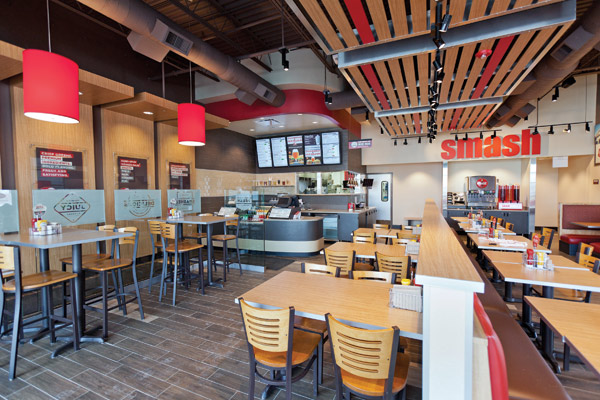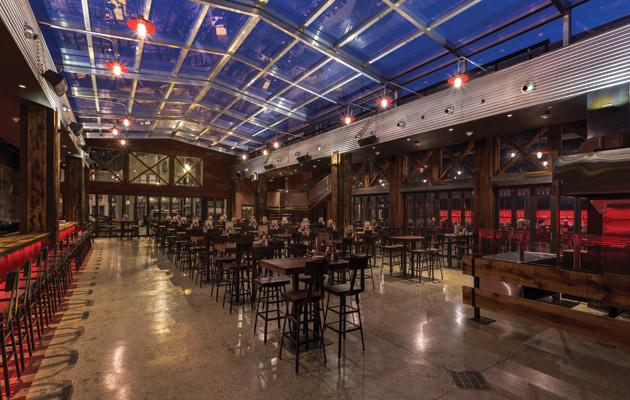A graduate of the Art Institute of Colorado, Jenn Allstun joined Smashburger two years ago, where she's helped to lead the better burger chain's rollout of its new "3.0" prototype. It's not her first foodservice gig: Allstun's held design positions at Starbucks, Rock Bottom Restaurants and Red Robin, where she first caught the restaurant bug.
With plans for 60 to 80 new units a year, advancement into new domestic, international and nontraditional markets, and a strong commitment to localize both its unit designs and its menus, Smashburger is on fire. It's never a dull moment for Allstun and her team, but that's just the way she likes it.
rd+d: What initially drew you to a career in restaurant design?
JA: I knew I didn't want to do residential, in part because the clients are so individual and the designer's role is very limited. I was working for an architectural firm and we got a contract to do the exterior architecture for Red Robin. At a meeting with senior management, I happened to ask about who was doing the interior design. They asked why and I said because I think I should. They had me put some ideas together and make a proposal and we ended up getting the interior contract as well. After that project, I knew I loved restaurant design. It's so collaborative — you get to work with real estate, marketing and construction departments; you're involved in the whole process of creating the experience for guests from start to finish.
rd+d: What does Smashburger's infrastructure look like on the design side? What do you spend most of your time on?
JA: Right now it's me and two other designers. We're very lean, but I think that helps to keep our focus sharp and we collaborate well together. We do all of the design and layout in-house. I also get involved very early on helping franchisees with site selection, feasibility studies, working with our architects and vendors going over plans and details so that we're not running into difficulties in the field. We work closely with marketing, too, so we know about new promotions or anything going on or coming up that that might affect our designs.
rd+d: What new project are you most excited about right now?
JA: We're designing a new unit in New York. It's our first store in Manhattan and even though it's a franchised location we're very involved. It will have a distinctively urban palette — we're using a lot of natural, raw materials such as wood, concrete and reclaimed bricks sourced from buildings in New York that were 100 to 200 years old. It's going to be a very cool space. We're using more reclaimed materials in general. They look great and give a more authentic feel to a space — plus we like the positive message that comes from the fact that we're using things that might otherwise have ended up being thrown away.

rd+d: What are some of the design highlights in Smashburger's latest prototype?
JA: It starts with our open kitchens. We're bringing the energy from the kitchen out into the dining area. For interior graphics, we're using a combination of storytelling boards that highlight our brand attributes and local-market imagery. We work hard to incorporate local elements into the design of every unit.
rd+d: Where do the ideas for that type of localization come from?
JA: We do a lot of research in each market. We might start with the chamber of commerce. If we're working with a local franchisee, we reach out to them for input, and we work with our PR firm for assistance identifying local landmarks, etc. We have an in-house team that creates the graphics. When people walk in, they'll see some Smashburger graphics that are consistent through the system, but they'll also see great visual representations of their own local community.
rd+d: How much flexibility do franchisees enjoy when it comes to their unit designs?
JA: We've created a tiered system with different price points and we offer a catalog of design elements — for example, full-height glass panels or low walls, or ceiling clouds if you have high ceilings or acoustical challenges. We offer various storyboards and specialty lighting choices. We try to offer a lot of different design options so franchisees feel like they are involved and can individualize their stores while still maintaining our brand standards.
rd+d: Have you recently implemented any particularly effective new cost-saving design measures?
JA: The biggest change is that we've introduced LED lighting platforms in all of our California and Texas markets. It's a bigger upfront cost but there are huge savings in the end. Our tiered approach to unit design has also allowed us to save money. It especially helps franchisees in markets where labor costs are higher, such as cities where contractors are unionized, to contain costs and still get the Smashburger look and feel.
rd+d: How are you applying technology to the Smashburger design process?
JA: We recently started using BIM. We can design anything in 3D and create snapshot images, which helps us to get the true design intention across to vendors and other people on our team. It makes the entire development process more efficient and saves us a lot of time and money in the field.
rd+d: What about your job do you find most challenging?
JA: There can be some really difficult phases in the design process, mostly having to do with the variety of sites that we work with. Some are very small, some on two levels, some with big columns that you have to work around. It's kind of like a puzzle that you have to figure out, and sometimes that's incredibly challenging. Sometimes it works best to walk away from it for a bit or sleep on it. I've been known to wake up in the middle of the night and pull out my computer when an idea for how to solve one of those puzzles strikes.
rd+d: What trends in the industry are you keeping a close eye on right now?
JA: Certainly open kitchens, LED lighting and the use of more organic materials are big ones. But also the broader use of new technologies in the front of the house — i.e., for making payments, maybe not even having someone at a register, but rather having customers place their own orders at a kiosk or screen at their table. I think we'll see a lot more of that and it has important implications for design and operations. It's very cool and I think it will work really well, but will also require a lot of pre-planning to get it right.
rd+d: Any particular restaurant design trends you'd like to see change or just go away?
JA: Maybe carpet tiles. They're great for office spaces but for our industry they're very hard to maintain and they're not very interesting. We should come out with some really cool, funky designs or bolder, bigger patterns. It's hard to find really cool carpet tiles that work in a restaurant.




